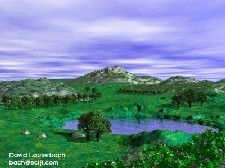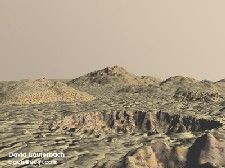Creating a Martian Greenhouse

Terraforming Mars will be a huge undertaking, if it is ever done at all. Initial stages of terraforming Mars could take several decades or centuries. Terraforming the entire planet into an Earth-like habitat would have to be done over several millennia. Some have even suggested that such a project would last thousands of millennia. So, how are we supposed to transform a dry, desert-like land into a lush environment, where people, plants and other animals can survive. Here are three terraforming methods that have been proposed:
- Large orbital mirrors that will reflect sunlight and heat the Mars surface.
- Greenhouse gas-producing factories to trap solar radiation.
- Smashing ammonia-heavy asteroids into the planet to raise the greenhouse gas level.
NASA is currently working on a solar sail propulsion system that would use large reflective mirrors to harness the sun's radiation to propel spacecraft through space. Another use for these large mirrors would be to place them a couple hundred thousand miles from Mars and use the mirrors to reflect the sun's radiation and heat the Martian surface. Scientists have proposed building mylar mirrors that would have a diameter of 250 km (155.34 miles) and cover an area larger than Lake Michigan. These gigantic mirrors would weigh about 200,000 tons, which means they would be far too large to launch from Earth. However, there is the possibility that the mirrors could be constructed from material found in space.
Advertisement
If a mirror this size were to be directed at Mars, it could raise the surface temperature of a small area by a few degrees. The idea would be to concentrate the mirrors on the polar caps to melt the ice and release the carbon dioxide that are believed to be trapped inside the ice. Over a period of many years, the rise in temperature would release greenhouse gases, such as chlorofluorocarbons (CFCs), which you can find in your air conditioner or refrigerator.
Another option for thickening the atmosphere of Mars, and, in turn, raising the temperature of the planet, would be to set up solar-powered, greenhouse-gas producing factories. Humans have had a lot of experience with this over the last century, as we have inadvertently released tons of greenhouse gases into our own atmosphere, which some believe is raising the Earth's temperature. The same heating effect could be reproduced on Mars by setting up hundreds of these factories. Their sole purpose would be to pump out CFCs, methane, carbon dioxide and other greenhouse gases into the atmosphere.
These greenhouse-gas factories would either have to be ferried to Mars or made out of materials already located on Mars, which would take years to process. In order to transport these machines to Mars, they would have to be lightweight and efficient. These greenhouse machines would mimic the natural process of plant photosynthesis, inhaling carbon dioxide and emitting oxygen. It would take many years, but the Mars atmosphere would slowly be oxygenated to the point that Mars colonists would need only a breathing-assistance apparatus, and not a pressure suit as worn by astronauts. Photosynthetic bacteria could also be used in place of or in addition to these greenhouse machines.
Space scientist Christopher McKay and Robert Zubrin, author of "The Case For Mars", have also proposed a more extreme method for greenhousing Mars. They believe that hurling large, icy asteroids containing ammonia at the red planet would produce tons of greenhouse gases and water. For this to be done, nuclear thermal rocket engines would have to be somehow attached to asteroids from the outer solar system. The rockets would move the asteroids at about 4 kilometers per second, for a period of about 10 years, before the rockets would shut off and allow the 10-billion-ton asteroids to glide, unpowered, toward Mars. Energy released upon impact would be about 130 million megawatts of power. That's enough energy to power Earth for a decade.
If it is possible to smash an asteroid of such enormous size into Mars, the energy of one impact would raise the temperature of the planet by 3 degrees Celsius. The sudden raise in temperature would melt about a trillion tons of water, which is enough water to form a lake, with a depth of one meter, that could cover an area larger than the state of Connecticut. Several of these missions over 50 years would create a temperate climate and enough water to cover 25 percent of the planet's surface. However, the bombardment by asteroids, each releasing energy equivalent to 70,000 one-megaton hydrogen bombs, would delay human settlement of the planet for centuries.
While we may reach Mars this century, it could take several millennia for the idea of terraforming to be fully realized. It took the Earth billions of years to transform into a planet on which plants and animals could flourish. To transform the Mars landscape into one that resembles Earth is not a simple project. It will take many centuries of human ingenuity and labor to develop a habitable environment and bring life to the cold, dry world of Mars.
Related HowStuffWorks Articles
More Great Links
- Bringing Life to Mars (Scientific American)
- Mars Images from the Mars Global Surveyor
- The Mars Society
- NASA's Mars Team Online
- Red Colony.com
- Technological Requirements for Terraforming Mars by Robert Zubrin and Christopher McKay
- The Terraforming Information Pages
- Terraforming Mars?
